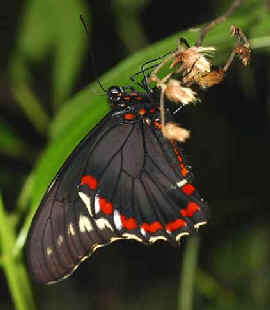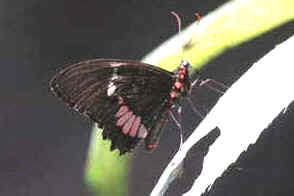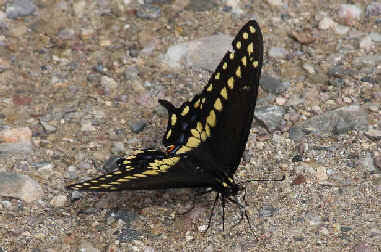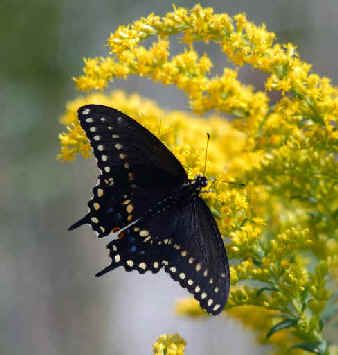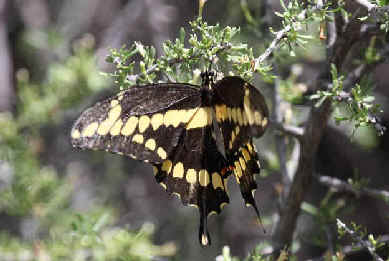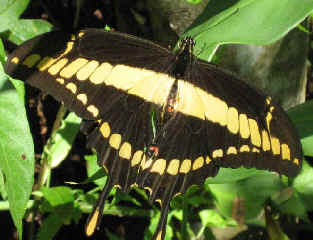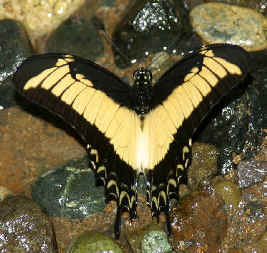
E-mail: font@focusonnature.com
Phone: Toll-free in USA 1-888-721-3555
or 302/529-1876
 |
PO
Box 9021, Wilmington, DE 19809, USA E-mail: font@focusonnature.com Phone: Toll-free in USA 1-888-721-3555 or 302/529-1876 |
 Part
1 of a List
Part
1 of a List
with some Photos
of
Central America
Butterflies
and Moths
Swallowtails
Noting those during
Focus On Nature Tours
in Belize,
Costa Rica,
Guatemala,
Honduras,
Panama
with tours in the months of: January, February, March, April, July,
December
First Part of a List of Central America Butterflies in 5
Parts,
compiled by Armas Hill
Here, in Part #1: Papilionidae,
the Swallowtails
Including, in this
list, photographs of: Polydamas Swallowtail, Giant
Swallowtail, Thoas Swallowtail,
Androgeus Swallowtail, Black Swallowtail
The above-right photo is of the black form of a Black Swallowtail. There is also
a yellow form.
Links to other Central America Lepidoptera groupings:
Part #2 - Whites, Yellows, Sulphurs & Allies (Pieridae)
Part #3 - Copper, Hairstreaks, Blues (Lycaenidae) & Metalmarks (Riodinidae)
Part
#4 -
Brushfoots (Nymphalidae) Part
#5 -
Skippers (Hesperiidae)
Moths
![]()
Codes relating to illustrations in various books:
Numbers noted as (BAPG:xx) refer to pages in
"Butterflies of Arizona - A
Photographic Guide", by Bob Stewart, Priscilla Brodkin, & Hank Brodkin
(with fine photographs).
Numbers noted as (BMCR:xx) refer to plates in
"Butterflies and Moths of Costa Rica" by Isidro Chacon & Jose
Montero
Numbers noted as (C:xx) refer to pages in
"A World of Butterflies", with text by
Brian Cassie, and photographs (superb) by Kjell Sandved
Numbers noted as (D1:xx) refer
to plates in "The Butterflies of Costa Rica and their Natural History (Volume 1):
Papilionidae, Pieridae, Nymphalidae", by Philip J. DeVries
Numbers noted as (F:xx) refer to pages in "The Illustrated Encyclopedia of
Butterflies", by Dr. John Feltwell
Numbers noted as (ICR:xx) refer to pages
with a photograph in "Butterflies, Moths, and Other Invertebrates of
Costa Rica, a Field Guide" by Carrol Henderson, 2010 (ICR
= Invertebrates Costa Rica)
Numbers noted as (K:xx) refer to pages in the
"Kaufman Focus Guide to Butterflies of North America", by Jim Brock & Kenn
Kaufman
Numbers noted as (MCA:xx) refer to pages in
"A
Swift Guide to the Butterflies of Mexico & Central America" by Jeffrey
Glassberg
Numbers noted as (PE:xx) refer
to plates in the "Peterson Field Guides to Eastern Butterflies", by Paul Opler &
Vichai Malikul, 1998 edition.
Those noted as (PEp:xx) refer to a page with a photograph.
Numbers noted as (PW:xx) refer to plates in the
"Peterson Field Guide to Western Butterflies", by Paul Opler & illustrated by Amy Bartlett Wright, 1999
edition.
Those noted as (PWp:xx) refer to a page with a photograph.
Numbers noted as (RG:xx) refer to pages in
"Butterflies of the Lower Rio
Grande Valley" by Roland Wauer.
Numbers noted as (S:xx) refer to pages in the
"Smithsonian Handbook, Butterflies & Moths", by David Carter.
Numbers noted as (100BM:xx) refer to
numbered plates in the book "100 Butterflies and Moths, Portraits from
the Tropical Forest of Costa Rica", by Jeffrey Miller, Daniel Janzen,
Winifred Hallwachs, 2007
Numbers noted as (100C:xx) refer to numbered
plates in the book "100 Caterpillars, Portraits from the Tropical Forest
of Costa Rica", by Jeffrey Miller, Daniel Janzen, Winifred Hallwachs, 2007
For both of these books, codes followed by -c:
indicates that there is in
the book a photograph of the caterpillar.
Actually for all of the species in both books, there are photographs of
caterpillars and the adult butterflies and moths.
To view the caterpillar and adult butterfly and moth photos online go to:
http://janzen.sas.upenn.edu/caterpillars/database.lasso
Additional Codes:
BZ: in Belize
CR: in Costa Rica
GU: in Guatemala
HN: in Honduras pb: at
Pico Bonito Lodge in the Caribbean lowlands
PN: in Panama sl: at
Sierra Llorona, in hills on the Caribbean side of Panama
BUTTERFLIES OBSERVED DURING FONT TOURS NOTED BY AN (*) AFTER THE 2-LETTER
COUNTRY CODE.
(ph): species with a photo in the FONT website
Other Links:
Itineraries
for upcoming Focus On Nature Tours in:
Belize, Costa Rica, Guatemala,
Honduras, Mexico, & Panama
Lists
of Birds in: Belize
Costa Rica Guatemala
Honduras
Panama
A List & Photo Gallery of Birds in Central America, in 4 Parts
A List of Mammals in Central America (with some photos)
Other Lists & Photo Galleries of Butterflies & Moths Elsewhere
Alphabetical Directory of Butterflies by Genus with Photos in the FONT Website
Directory of Photos in this Website
List of Central American Butterflies, Part
#1:
Family PAPILIONIDAE: SWALLOWTAILS (and allies):
Worldwide, there are totally
about 550 known species of Swallowtails.
Butterflies in PAPILIONIDAE
have 3 pairs of legs (distinctive from the NYMPHALIDAE, the "Brushfoots").
Most flutter their wings when
feeding.
The occur in a variety of
forms, colors and sizes (usually mid to large size butterflies).
Most species have elongations
in the hindwings (the "'swallowtails").
But the genera Battus
and Parides are "tail-less".
PAPILIONIDAE butterflies
feed on flowers (they are excellent neotropical tree-pollinators)
or on wet soil for dissolved
mineral salts.
Some congregate in large
numbers, especially males.
Larva of many PAPILIONIDAE
species feed on plants containing alkaloijds, or other substances, that
are
then included in the
butterfly's system for defense.
Host plants are in a
variety of families, such as Aristolochiaceae, Rutaceae (the Citrus
family), Annonaceae,
Piperaceae (the pepper
family), and others.
Genus BATTUS: PIPEVINE SWALLOWTAILS:
Totally 15 species
